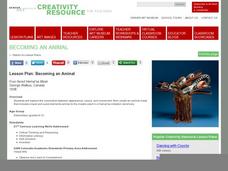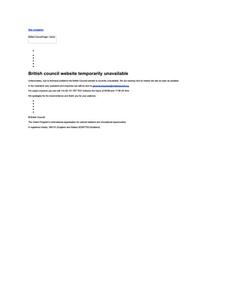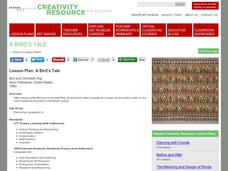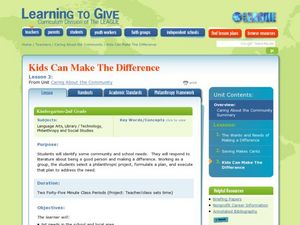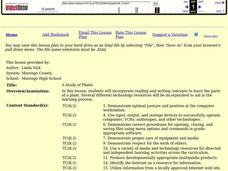Curated OER
Lesson Plan: Becoming an Animal
The Kwakwaka'wakw are indigenous people from Vancouver Island and British Columbia. The class analyzes a Kwakwak'wakw ceremonial mask, how it was used, and its cultural significance. They then create animal masks representing their...
Curated OER
Recreate the Race
Students research and find the route of the Alaskan dog sled race.In this Iditarod race lesson students find the checkpoints for the Iditarod on a map. Students research information in pairs about each one of the checkpoints. Students...
Curated OER
Teaching Numbers with Primary Pupils
One, two, three. Un, deux, trois. Eins, zwei, drei. Primary learners love to count and this lesson contains a series of games that encourage learners to count in English, French, German, and Spanish. The exercises develop literacy and...
Curated OER
The Big Squeeze
Students observe what happens as crayon shavings are melted and/or pressed together. They compare this to the process some rocks go through as they are heated and compressed naturally on earth.
Curated OER
Observing the Changes: The Warming of the North
After reviewing the causes and effects of climate change, students become observers for "Plant Watch," a program to monitor the effects of climate change on plants. Students record blooming and leafing dates for selected local species...
Curated OER
Lesson Plan: A Bird's Tale
Who wouldn't love to get a letter from a blue bird? Elementary art enthusiasts analyze the social and historical context of Ason Yellowhair's Navajo piece, Bird and Cornstalk Rug. They examine the construction and images on the rug...
Curated OER
Fish and Clips
Youngsters test magnetic strength by measuring the mass of paper clips that they "hook" with a magnet. Your first and second graders should love the hands-on activities associated with this plan. The reproducible materials are quite good...
Curated OER
Animals Galore
A well-designed instructional activity which covers the characteristics of the animals found in the six animal groups is here for your young biologists. In it, learners divide up into six groups; the amphibians, reptiles, mammals, birds,...
Curated OER
Past Simple
Hop on the computers for this fun past simple practice! First, users match eight pictures to their written descriptions. Then, they study some irregular verb rules, and finally, they use two models to describe six pictures. A great...
Curated OER
Water - Our Future
How is it that water that falls as rain ends up coming out of the tap on our sinks? Learners trace water's journey and examine how along the way pollutants make their way into the water supply. They conduct experiments, use the Internet...
Curated OER
What Do You See at the Pond?
With What Do You See at the Pond?, young readers explore pond life and practice reading strategies. Learners first make predictions and then read the simple story independently. After a second read-through with a partner, kids come...
Curated OER
Word Families: ake
Young learners create a book of words that use the letter combination ake. Six pages are included for them to cut and color, and there's a space for them to trace the letters of the word as well as write the word independently. The...
Curated OER
Vocabulary Building
A fabulous language arts lesson has readers focus on the vocabulary in the key words, expand and build new vocabulary, and practice three grammar concepts. They recognize key words as they relate to communicating at work. Pupils build...
Curated OER
Specialized for the Sea
Students use pictures and make a mural to investigate how ocean animals are adapted to certain parts of their environment.
Curated OER
Magic Tree House: Midnight on the Moon
Take your class to the moon with Midnight on the Moon! Then provide them with this short packet to develop vocabulary and practice reading comprehension. The first page has readers match vocabulary terms to their correct...
Curated OER
Kids Can Make a Difference
What is a philanthropist? We can all be philanthropists! After assessing the needs of the school and listening to literature about how they can help others, primary learners develop a class project and maintain a journal of their...
Curated OER
Rules for Rubrics
How do you create an effective and fair rubric? Read this article to create the best rubric possible.
Curated OER
What A Pair! A Cross Grade Writing Activity
What a pair! Older pupils interview younger ones and use what they learn to write a short, illustrated storybook that features the youngster as the main character. The youngster responds with a thank-you note in which they identify their...
Curated OER
Marking Time
Two narrative excerpts tell the same story from different points of view. In the first excerpt (first person), sequencing words and phrases are bolded and learners write down what the bold type does. The second excerpt is in third...
Curated OER
A Study of Plants
Using a variety of multi-media resources, your high schoolers become familiar with the parts of plant and create a story about plants using vocabulary learned during their research of plants. Completed stories are published using the...
Curated OER
Think Pair Share
Here is a great tool to help train your learners what to do during a think pair share! The graphic organizer has a place for your learners to put the title, their partner's name, notes during their peer discussion, and a place to record...
Curated OER
Printing and Publishing
Explore African literature and artwork in a multicultural literacy and art lesson. Begin with a read aloud of Tiger and the Big Wind: A Tale from Africa, and afterward, have kids retell the main events in the story. They...
Curated OER
Who Works at Our School?
Young interviewers will learn more about the school staff by asking them questions and creating a bulletin board display. They will learn how to make thoughtful interview questions, conduct professional interviews, and organize...
Curated OER
Questioning
Practice making predictions by looking at the cover of a book. You can use The Hungry Thing, as suggested here, or any other book you may be reading in class. Use the predictions to talk about good reading strategies. A chart is...
